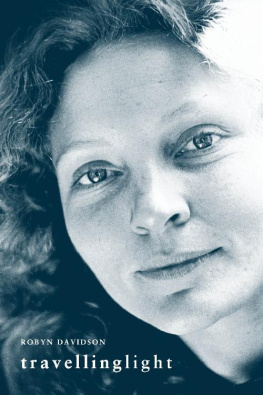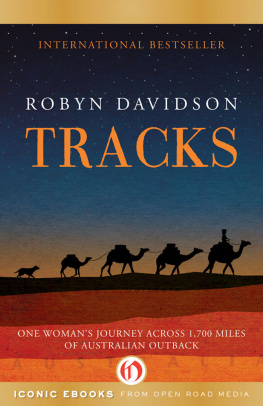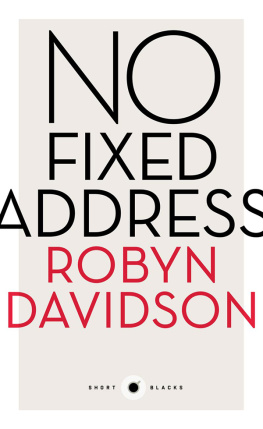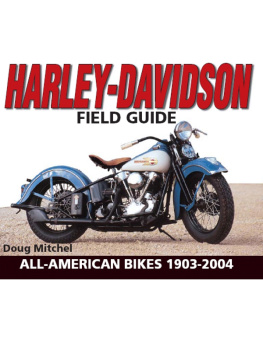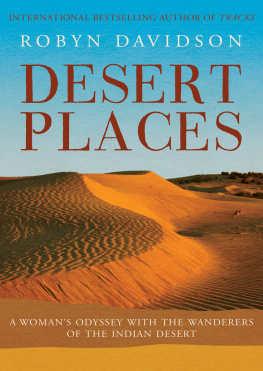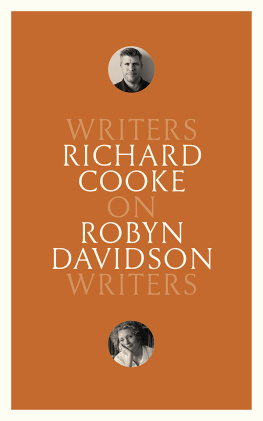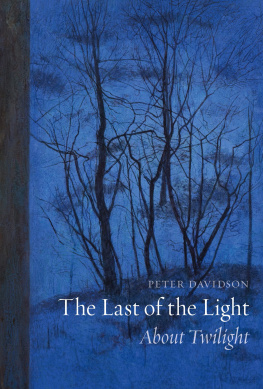Robyn Davidson was born on 6 September 1950 in the Queensland town of Miles. Her journey by camel through Australias interior was published to worldwide acclaim as Tracks (1980). She has published travel articles and autobiographical essays in many leading newspapers and magazines, and these are the basis for Travelling Light.
This edition published by ETT Imprint, Exile Bay 2017
ETT IMPRINT PO Box R1906
Royal Exchange NSW 1225 Australia
This book is copyright. Apart from any fair dealing for the purposes of private study, research, criticism or review, as permitted under the Copyright Act, no part may be reproduced by any process without written permission.
Inquiries should be addressed to the publishers.
First published by Imprint Travel 1993
Copyright all stories, Robyn Davidson 1989, 1993, 2017
ISBN 978-1-925416-81-7 (ebook)
ISBN 978-1-925416-83-1 (paper)
Cover photograph by William Yang:
Dee after she crossed the desert
ACKNOWLEDGMENTS
Some of these articles have been published previously in a different form in the following newspapers and magazines: the Sydney Morning Herald, the Age, Womens Day, London Sunday Times, the National Times. The Mythological Crucible was first published in Australia, Beyond the Dreamtime (Heinemann/BBC, 1987) as a slightly different version; Alice Springs was first published by Collins Publishers Australia in 1989.
To keep the earth on ones roots and find another earth, that is a real miracle.
Marc Chagall
CONTENTS
THE MYTHOLOGICAL CRUCIBLE
1987
I was born in 1950 in the one-horse hospital of Miles, our nearest town, twenty-five miles away. It was a good year for Virgos, Robyns, and wars both hot and cold. The bumper crop of September births is easy enough to explain. The deprivations of the Pacific war were beginning to fade from memory, and there was enough money around not only to send care packages to England (a country my forbears had not seen for several generations but which some of them continued to call home), but also to lash out on enough cold beer around the Yuletide season to forget about the importance of contraception. The burgeoning quantity of Robyns born in that decade remains a mystery.
At about the time I was being conceived, and myxomatosis was being introduced to exterminate the rabbit plague nibbling away at the roots of Australias economy, a new government was being sworn in, to replace the Labor government which had seen Australia through the final years of the war. It was led by a bushy-eyebrowed man who rode to power on the promise of exterminating the Communist Party, which, according to him, was also decimating Australias economy. It began what is known to history as the Menzies Erasixteen years of it followed by a further seven years of conservative rulethe Big Sleep. According to my parents he was a shining statesman and a witty speaker. He was the good shepherd, who coaxed his bleating public into the safe pastures of economic prosperity and protected it from the dingo-like ravages of the Yellow Peril. He loved the Queen. He loved cricket. He was, above all, safe. There are other interpretations however. As an acquaintance of mine put it recently: Menzies was a poisonous old fart, hanging around the backside of Great Britain. As the word fart had never been heard in our household, I adhered, in my youth, to my parents view.
We lived, my mother, father, sister and I, on a smallby Queensland standardscattle property called Stanley Park. Even then the name seemed inappropriate to me. Parks were things which existed in places called London or Europe and they had oak trees and daffodils, fairies and Peter Pan. Rarely did we receive enough rain to turn the yellows and ochres of the Downs country into a poor excuse for green, or to send a muddy torrent choked with topsoil, bloated cattle and torn-up river gums down the wide, white creek bed which passed beside our house. It was one such torrent which almost carried our house away, and caused my father to sit on the front steps with his head in his hands, contemplating his losing battle with the bush and the bank. For we children, the thunderstorm was the most thrilling event in our lives. Hail lay a foot thick where once there had been dry grass and bluebells. Joyously we filled buckets with these miracles of ice, while our parents discussed selling up.
Although I left Stanley Park when I was four, I remember, like a taste or a smell, a forlorn, deserted quality the country had. It was as if loneliness seeped out of the soil into the bright, brazen light. But of course that was a projection on my part, brought about, perhaps, by a guilty race conscience. Not far from where we lived a group of blacks had been murdered in a dry river bed fifty years beforea common enough occurrence during the dark ages of Australian history, which began in 1788 and continued until 1928, when the last recorded massacre of Aboriginal families took place. So carefully had my antecedents obliterated history that I knew nothing of this at the time. It would be many years before I discovered the rot which riddled white Australias history, beneath the evasions, silences and lies, and longer still before an Australian prime minister would say: More than any foreign aid programme, more than any international obligation we meet or forfeit, more than any part we may play in any treaty or alliance, Australias treatment of her Aboriginal people will be the thing upon which the rest of the world will judge Australia and Australiansnot just now, but in the greater perspective of history.
Our house was a typical bush homesteadrambling, ramshackle and set up on stilts to keep it cool. A succession of blue cattle dogs was chained up under the tank stand. A hardy variety of bougainvillea blazed along the peeling weatherboard walls; welcome swallows made their homes under the corrugated iron roof; deadly snakes made theirs in the woodpile. A succession of black and white cats prowled a wide veranda gauzed in by a fine wire mesh which, while effectively shutting out most of the relieving breezes of sundown, was no match for the squadrons of insects that kamikazed by the million each night into the hurricane lamps. It was these kinds of domestic difficultiesthe spiders webs, the dust, the piles of desiccating insects, the stray snakes and the lack of those modern appliances like vacuum cleaners and electric irons that littered the kitchens of her city chumswhich caused my mother to sit on the back steps with her head in her hands.
Or perhaps it was the isolation that got her down. Her view, from those back steps, was of never-ending sameness. A solemn, empty, dry flatness with no distant mountains, no dazzling streams, no rich greens to relieve the eye. Yellows, sepias, drab bluey-greys stretched away to meet the empty blue vault, which bleached out as the day progressed and the sun crushed the vitality out of everything. One hundred years before, the explorer Ludwig Leichhardthero of Patrick Whites novel Vosspassed across our land on his second attempt to cross Australia from east to west. He carved a large L into a tree up in our brigalow forest before disappearing forever into the same oblivion as that which yawned before my mothers eyes. She was a city woman, used to an exciting social life. In her youth she had sung in operas, dressed herself up in chiffon and flowers and danced like Isadora Duncan. Oddly, my strongest image of her comes from a time before my birth. She described to me how, as a young woman, she had gone on a picnic with friends, and they had all decorated each other and the car with wild flowers. There were very few wild flowers at Stanley Park.
Our nearest neighbour lived three miles away. Our closest link with Elsewhere was the siding at Gulugabaa tin shed beside the railway line. At the end of the long, rutted track in front of our house was a tin box on a stump, into which, once a week, were placed letters full of news and tacit sympathy from my mothers coast-clinging relatives: she was grateful for both. The wireless was our only other contact with the faraway world of events. Sometimes the cicadas and crickets were so loud that we had to turn it up to hear our favourite childrens programme, The Argonauts, or our favourite serial, Blue Hills, or the Sunday play. When it came to news time my father moved his chair closer, cupped his hand over a war-damaged ear, puffed on his pipe and listened avidly. He may well have heard Menzies proclaim:
Next page
